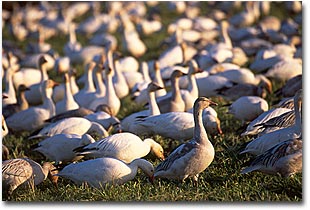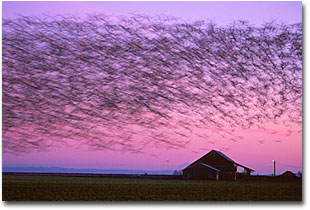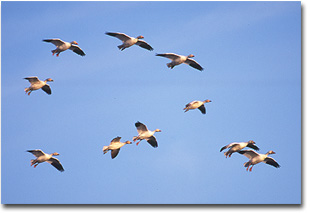|
|
 Snow Geese - Born to Migrate
Text and photography Copyright Nandakumar Sankaran
My first encounter with snow geese was rather brief. While driving through the backroads of Skagit Valley north of Seattle, a large patch of white on an otherwise barren brown field caught my eye. As I passed a US Fish and Wildlife refuge, I realized that the large patch of white was actually a huge flock of wintering Snow Geese. I made a U-turn on the narrow backroad and entered the refuge's parking lot. As I got out of the van, camera in hand, the huge flock took flight, an initial murmur quickly transforming into a thunderous roar as tens of thousands of Snow Geese flapped their wings and exchanged calls as they scouted a new feeding ground. Within minutes, the flock settled on a farther field, starting to feed once again. For the remainder of that day, the flock receded farther and farther into the distance, leaving us with no opportunity to observe or photograph them. However, the momentary experience of watching the birds, as they took flight, encouraged me to learn more about the birds and re-visit this wintering ground with hopes of better opportunities to observe and photograph them before they embarked on their northerly migration to arctic nesting grounds. Native Indians of North America have long observed the seasonal migration of snow geese, but it was only recently that their nesting grounds were discovered. Aptly, they were named Chen Hyperboreus meaning "from beyond the north" and blue geese, once thought to be a different species but now understood to be just a 'phase' of the white snow geese, were named Chen Caerulescens. Now scientists use the latter scientific name to refer to both phases of the snow geese. The sexes of both phases look alike. White phase birds are pure white with black wing tips and pink beak and feet while juveniles have grey white plumage in their first year. Blue phase adult birds have white heads but greyish blue body color and juveniles have slate grey plumage all over, including the head. Blue geese migrate through the prairies of the mid-west and are rarely found on the West Coast. The phases of blue and white snow geese is known as plumage dimorphism. During the wintering season, snow geese will exhibit rusty patches on their head and the undersides of their body and feeding on water with high iron content causes this temporary coloration. Snow geese differ from their closest relative, Ross's geese, by having a "grinning patch" at the end of their beaks and being physically larger. Ross's geese have shorter and stouter bills. The two species sometimes mate, producing offspring with mixed features. Snow geese nest in the arctic region, along the northern tips of Canada, Alaska and Greenland. Scientists do not yet fully understand how snow geese are able to routinely find their nesting grounds in the barren arctic tundra but it has been observed that the birds return to the same area where they hatched. Geese find their mates during the winter feeding season and they generally forge lifelong bonds. By late spring, they start their northerly migration to their nesting grounds and wait for onset of summer. Once the ground begins to thaw, the female builds a nest and starts laying eggs, usually one every day and missing a day before laying the final egg in her clutch. A female lays an average of 4 eggs in a clutch. Once all the eggs are laid, the female lines her nest with her down feathers and begins incubation, which lasts 23 days. During this period the gander stands guard beside the nest, warding off predators. Both the male and female spend almost all the time near their nests primarily because unguarded nests become vulnerable to predators such as foxes and Jaegers. Another reason is that an exposed nest loses heat-causing delays in hatching. Geese essentially fast during this period and females typically lose 20% of their body weight. They depend upon nutritional reserves built up during the preceding winter and spring feeding months. Given this situation, it is all the more important that bird watchers not get overzealous and stress out the birds during the feeding months. If adequate reserves are not built up, geese will succumb during nesting to a combination of freezing arctic temperatures and starvation. Despite the fact that eggs were laid one per day, all the eggs in a clutch hatch around the same time. The entire colony of geese complete egg laying, incubation and hatching of goslings in just over a month - between May and June. Goslings are born with fuzzy yellow feathers and they learn to walk and feed themselves within the first 24 hours. They instinctively peck at the ground for food almost immediately after hatching. For the first few days after the eggs are hatched, the goslings derive nourishment from the still attached yolk sac. During this time, in a process called brood migration, the adults lead the goslings to nearby feeding areas. Goslings track the largest objects they see around them, which are usually their parents, a phenomenon called imprinting. Around the time the eggs hatch, the adults molt, losing most of their flight feathers and getting grounded. In 5-6 weeks, the adults re-grow their feathers and by this time, the goslings will also have learned to fly.
By late August and early September, adult and immature geese migrate southwards towards their wintering grounds, when the arctic starts getting colder. They fly in neat long lines or V-shaped formations. Scientists believe that this formation causes favorable air currents and riding them makes it easier for the geese to cover longer distances. Located in the pacific flyway, Skagit flats are major wintering grounds for the snow geese. Skagit valley and the Frasier river delta just north of the Canadian border are the first areas free of snow while coming south from the Arctic. These are also the first big estuaries that are conducive to supporting the migrating geese population. Extensive aquatic vegetation, moderate temperatures, waterlogged fields and large moist farmlands make these areas very attractive for the snow geese to overwinter. At night, they rest in the waters of Skagit bay. In the Skagit valley, vast areas are protected by the Washington Department of Fish and Wildlife (http://www.wa.gov/wdfw). In conjunction with local farmers, they plant grass and winter wheat that are favorable for geese. During the wintering months, geese feed heavily in the fields and on roots, rhizomes (particularly on Scirpus Americanus, commonly known as three square sedge) and tubers at the tidal flats, building up bodily reserves for the next summer's nesting season. Wintering grounds play another important role in the life of geese. It is here that the geese find their mates typically during their second winter (although they donít mate until their third winter). A female goose typically finds a mate that is the same color as her parents and the forged bonds usually last life-long. Snow geese live an average of 8 years, breeding for 6 of those years. Washington Department of Fish and Wildlife manages the geese population by permitting hunting, setting bag limits and hunting durations based on the nesting successes of the preceding season. The department tries to maintain the population levels at 35000 geese, closing the hunting season early if the population drops. Snow geese are very adaptable and its ability to elude hunting mortality has caused it to thrive despite such management restraints. Hunting is only permitted at specially marked areas and a hunting and parking permit is usually required for using such areas. Check with the Washington Fish and Wildlife department in the La Conner area (360 466-4345) for hunting information. The Padilla Bay National Estuarine Research Reserve (1043 Bayview-Edison Road, Mount Vernon, WA 98273, Phone: (360) 428-1558) is a good resource for other birds that are commonly found in this valley. Head north from Seattle on I-5 to exit 226. Follow WA 536 to WA 20 and look for signs to turn north towards the reserve and nearby Bay View State Park. While you are at the Interpretive Center, pick up maps listing favorable spots for watching birds. Typically, snow geese make their home in the delta between Conway and La Conner, along the Skagit Bay. Padilla Bay is one of the very few estuarine reserves designated around the nation. This bay is home to a variety of birds including brandts, eagles and raptors. Expect to find predatory birds especially during the waterfowl migration season through this area in winter and early spring.
At the start of spring, by late February or early March, the birds would have built up enough reserves to embark on their northerly migration to the nesting grounds. Flying at typical heights between 750 and 3500 feet, it would take 10 to 11 weeks to reach the nesting sites. En route, the flock would meet other flocks returning from other wintering sites and stop to feed whenever possible. Geese of the pacific flyway migrate to nesting grounds in Russia's Wrangel Island, northern Alaska and western Canadian arctic. Here they wait until the ground starts to thaw, before building their nests, laying eggs and starting the cycle all over again. Quick Facts about Snow Geese
About the images... All images were made in the Skagit valley region of Washington state between Conway and La Conner, WA on Fujichrome Velvia using a Canon EOS Elan IIE with a Canon EF 100-400/4.5-5.6L IS USM mounted on Bogen 3221W tripod.
Nandakumar Sankaran - NPN 324 Editor's Note - View more of Nandakumar's work on his personal website, http://crookedtrunk.com. Comments on this article? Send them to the editor. |
|
|

 It is peak summer in the arctic tundra when the goslings are hatched. Wildflowers and vegetation are at a rapid growth and an almost constant summer sun provides long feeding days for the starved adults and the newly hatched goslings. However the arctic vegetation has a very narrow window of opportunity for growth, given the relatively short summer season. Geese's feeding habits are very destructive to the plant habitat. With the right population balance, vegetation will usually recover by the next spring when the birds return to the tundra. However, in the past two decades, snow geese populations have steadily grown to a point where they are causing increased pressure on the arctic vegetation that is unable to recover in a year's time. Scientists are already finding vast areas that are now barren that were once prime geese feeding areas. The geese are, in turn, forced to migrate their brood over farther distances from the nesting grounds to find food. The longer migration saps energy and makes goslings grow more slowly, in turn leading to higher mortality rates. The receding arctic vegetation is also affecting other animal and bird colonies that depend upon the very same feeding grounds for their survival.
It is peak summer in the arctic tundra when the goslings are hatched. Wildflowers and vegetation are at a rapid growth and an almost constant summer sun provides long feeding days for the starved adults and the newly hatched goslings. However the arctic vegetation has a very narrow window of opportunity for growth, given the relatively short summer season. Geese's feeding habits are very destructive to the plant habitat. With the right population balance, vegetation will usually recover by the next spring when the birds return to the tundra. However, in the past two decades, snow geese populations have steadily grown to a point where they are causing increased pressure on the arctic vegetation that is unable to recover in a year's time. Scientists are already finding vast areas that are now barren that were once prime geese feeding areas. The geese are, in turn, forced to migrate their brood over farther distances from the nesting grounds to find food. The longer migration saps energy and makes goslings grow more slowly, in turn leading to higher mortality rates. The receding arctic vegetation is also affecting other animal and bird colonies that depend upon the very same feeding grounds for their survival. One sunny day in late winter, we set out to the Skagit delta in hopes of finding the wintering geese for close observation. We routinely stopped at each of the areas recommended by the naturalists at the Padilla Bay Reserve and on Maupin Road near La Conner. We found the entire flock of birds feeding right beside the country road. Snow geese are very wary of humans and one cannot approach them at very close ranges. Nevertheless, since they were feeding right beside the road, one couldn't have asked for a closer encounter. Armed with my 400mm lens, I was fortunate to make some images of the flock. For the rest of the day, they fed on fields right beside the same road and one only had to walk the length of that road to keep up with the birds. On this particular day, the birds continued feeding even after sunset and it was only when the alpenglow on Mt. Baker in the background disappeared that they seemed content to call it a day. There were lots of opportunities for me to photograph the feeding flock, individual families in flight, the entire flock taking flight and birds returning to the bay at the end of the day, against a pink sky.
One sunny day in late winter, we set out to the Skagit delta in hopes of finding the wintering geese for close observation. We routinely stopped at each of the areas recommended by the naturalists at the Padilla Bay Reserve and on Maupin Road near La Conner. We found the entire flock of birds feeding right beside the country road. Snow geese are very wary of humans and one cannot approach them at very close ranges. Nevertheless, since they were feeding right beside the road, one couldn't have asked for a closer encounter. Armed with my 400mm lens, I was fortunate to make some images of the flock. For the rest of the day, they fed on fields right beside the same road and one only had to walk the length of that road to keep up with the birds. On this particular day, the birds continued feeding even after sunset and it was only when the alpenglow on Mt. Baker in the background disappeared that they seemed content to call it a day. There were lots of opportunities for me to photograph the feeding flock, individual families in flight, the entire flock taking flight and birds returning to the bay at the end of the day, against a pink sky.